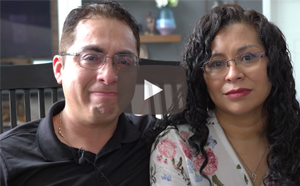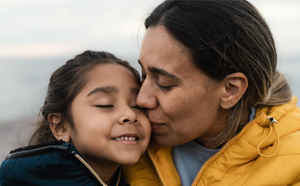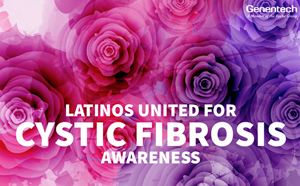We Are
The Extended
CF Familia
Five tips for integrating school life and Cystic Fibrosis
by Olga G.
Patient testimonials represent individual experiences and opinions of the individual patient. Experiences may vary.
Many significant social activities take place at school. Through school age, children are involved in endless learning that will shape their personality, their future, and their conscience. In addition to learning, as parents we want our children to enjoy and grow at school, creating invaluable memories of their time in the classroom, but sometimes, it doesn’t turn out that way.
My daughter Olga María was diagnosed with cystic fibrosis (CF) when she was three months old. Despite the therapies she had to undergo since she was a baby, including a powerful vibrating vest and upping her salt intake to combat her excessive sodium loss, she was always calm, playful, and a very happy baby.
Throughout her 12 years of age, we have been learning together how to integrate her condition with her school environment. Therefore, I want to share the key learnings that have helped me in this stage of her life:
1. Talk about cystic fibrosis (CF)
Her first experience with other babies in a class was in early stimulation sessions, around seven months old. In this first class, Olga María coughed with that exaggerated cough and phlegm that is characteristic of this disease.
The minor incident was extremely uncomfortable – other mothers looked at her, looked at me, and some subtly took their little ones and left.
Immediately afterward, I realized the importance of sharing and reporting Olga María’s condition, explaining it to the teacher and she in turn explained it to the group of mothers in detail – what it consists of, the characteristics of cystic fibrosis (CF), and that it does not represent any risk in any way to their children nor is it contagious. Normalization is very important to promote easy integration, you need to address the issue naturally with all parties.
2. Prepare, plan, and organize
After early stimulation classes for babies, Olga María continued with pre-school, kindergarten, and elementary school. At three months of age, Olga María began her breathing therapy, initially applying vibration with manual percussions, and then she started with the vibrating vest to help break up the phlegm that forms in the lungs more easily. To date, she has been very disciplined.
Related school-age activities such as sleepovers, camping, or going to the park apart from being fun, stimulate independence and the development of social skills; however, although they are considered normal, they are more difficult for a child or adolescent living with cystic fibrosis (CF).
Preparation, planning, and establishing communication with the school, teachers, parents of other children, and facilitators of extracurricular activities and classes are required. They need to be informed about the care and/or therapy regime of a child or teenager with cystic fibrosis (CF). This way, information and support about care can be communicated naturally.
Educational and explanatory information through brochures, books, talks, and virtual or face-to-face conferences to understand this illness have been key support tools for those of us who are primary caregivers. I’ve shared all this information with people and organizations that Olga Maria interacts with to promote understanding of:
- The digestive condition of people with cystic fibrosis (CF) and the frequency and/or urgency of using the bathroom
- Eventual coughing
- Flexible time for physical exercise and school absences for medical visits or hospitalizations.
3. Try new therapies or discoveries
Knowing that Olga María will have to practice therapy and/or take medications for life was devastating; however, we were fortunate, since her diagnosis, to have access to crucial information and support from specialists for her comprehensive care, and to share it, has been relishing.
Children’s Hospital Los Angeles, an organization that routinely provides care for Olga María since her diagnosis has provided us with information and material that we have been able to share with Olga Maria’s school to make them aware of any new therapies or discoveries she is participating in.
Olga María has participated in new studies that are carried out with the aim of discovering and/or improving medical alternatives that allow improvement in treatments for people with cystic fibrosis (CF).
Joining forces and getting involved in the well-being of others, especially children and teenagers, undoubtedly elevates us as a community, makes us better human beings, and improves our coexistence and the environment we all share.
4. Join Support Groups
Along my journey in coping with cystic fibrosis (CF), I have fortunately found support groups where people are eager to receive and provide support. The digital age has undoubtedly facilitated more and more interaction and access to information and real people, who share their own testimonials, experiences, thoughts, and emotions, creating strategies, and seeking to eliminate stigmas, as a result of sharing this condition as a group.
The influence of group integration is an effective means of empathy, expression of feelings, and support that helps to define situations, solutions, and new perspectives more clearly. Support networks certainly facilitate cooperation and understanding between each other.
5. Create a communication network (Call Tree)
Communication is key. The people closest to us represent a support nucleus for a child, a relative, or a friend with cystic fibrosis (CF).
This disease should not prevent you from having a life as normal as possible. It is essential to find a way to reconcile care and achieve effective social insertion.
Many people are involved in Olga María’s health care – from her family, doctors, nurses, social workers, and pharmacies to the school principal, teachers, and classmates. For this reason, I gathered all their information, names, phone numbers, and key addresses, in a friendly format such as a call tree with the aim of facilitating communication between primary and secondary caregivers in the event of emergencies.
Periodically review the call tree to ensure the information is up to date, including an updated list of emergency contacts that should contain basic location data, a description of medications and how they should be taken, and a general procedure for emergencies. This will give you a sense of ease that the call tree works.
There is no such thing as too much when it comes to the care of our loved ones with cystic fibrosis (CF). The more we know, the better it will be because everyone will be able to better understand the situation, help more, and not make the illness taboo. Let us all be flag-bearers of cystic fibrosis (CF).





